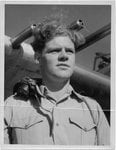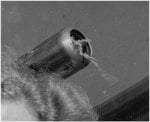Hamiltonian
Airman
- 49
- Feb 17, 2014
Hello. My mother recently found a photo of my late father, posing by the wing of what I believe is a P-47 "razorback", which the RAF designated a Thunderbolt Mk. I. He flew with 135 Sq. RAF during the first half of 1945, out of Jumchar and Akyab in Burma, at a time when they were using Thunderbolt I's.
What intrigues me is that there seems to be pieces of rag stuffed into the gun barrels behind his head. I'm aware that the RAF used doped tape (for flush mounted guns) or some sort of condom arrangement to keep foreign bodies out of the gun barrels, but this is a new one for me.
Can anyone explain what might have been going on?
If I've done this right, I've attached a small version of the whole picture, and a detail of the most visible gun barrel.
What intrigues me is that there seems to be pieces of rag stuffed into the gun barrels behind his head. I'm aware that the RAF used doped tape (for flush mounted guns) or some sort of condom arrangement to keep foreign bodies out of the gun barrels, but this is a new one for me.
Can anyone explain what might have been going on?
If I've done this right, I've attached a small version of the whole picture, and a detail of the most visible gun barrel.


